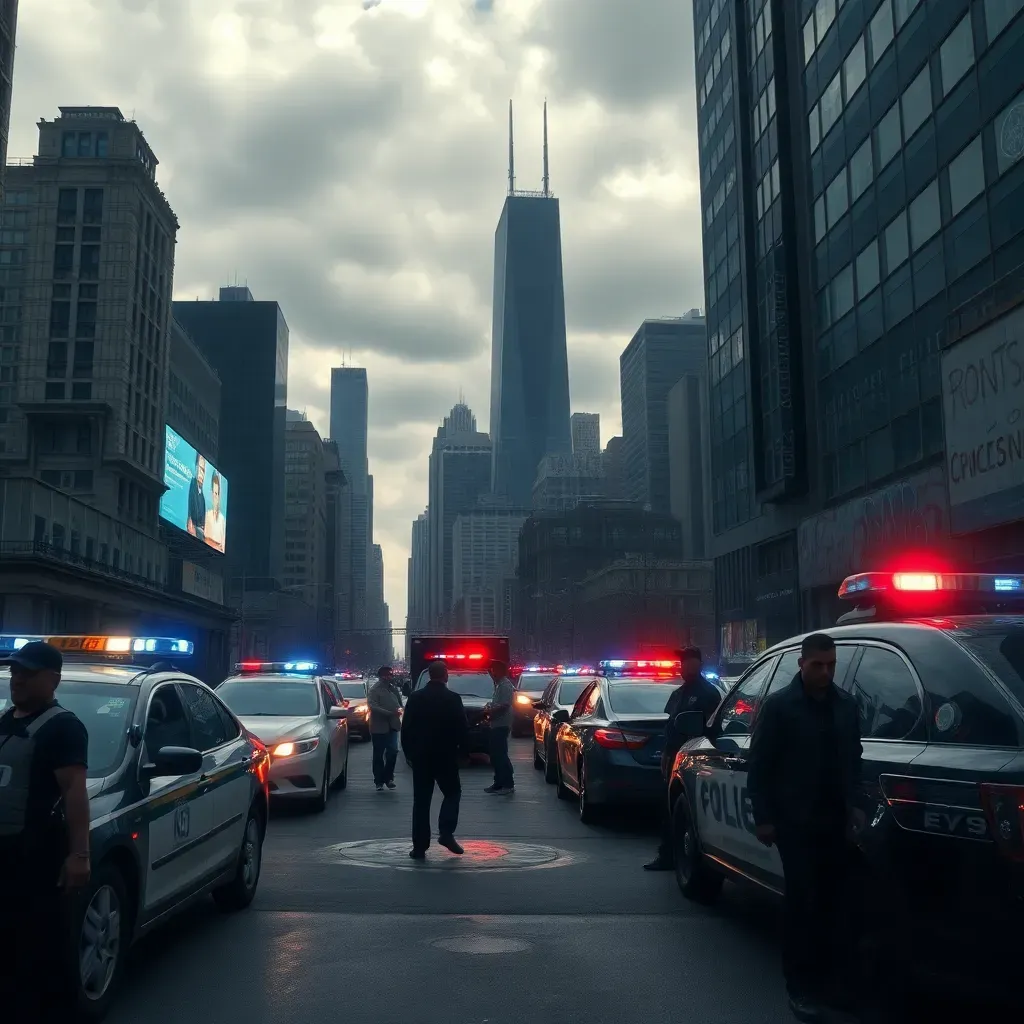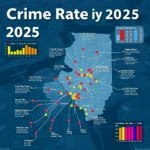Crime rate in Chicago 2025: What the shocking numbers really mean
- Is Chicago Still One of the Most Dangerous Cities in the US in 2025?
- Chicago Crime Rate 2025: What The Latest Data Tells Us
- Breaking Down The Crime: What Types of Crime Are Most Common in Chicago?
- Neighborhoods Matter: Where Are The Riskiest and Safest Spots in Chicago?
- Why Does Chicago Get Such a Shady Reputation? Separating Myth from Reality
- What’s Driving Crime Trends in Chicago in 2025?
- How Safe Are Chicago’s Tourist Spots and Business Areas?
- What Can Residents and Visitors Do to Stay Safer in Chicago?
- Voices From The Streets: What Chicagoans Really Say About Crime in 2025
- Comparing Chicago’s Crime Rate With Other Dangerous Cities in the US
- What’s Next for Chicago? Crime Prevention and Future Outlook
- The Real Deal on Chicago’s Crime Rate in 2025
- Sources and Further Reading
Is Chicago Still One of the Most Dangerous Cities in the US in 2025?
Heard Chicago’s crime rate is wild? Let’s see what’s really going on in 2025. Chicago’s got a rep for being one of those sketchy, rough, and risky cities in the US. But is that all there is to the story? We’re diving into the numbers, neighborhood realities, and what it means for folks living here or just curious about safety. No fluff, just straight talk for anyone wanting to understand Chicago’s crime scene and how it stacks up against other dodgy cities in America.
Chicago Crime Rate 2025: What The Latest Data Tells Us
The latest official crime stats from the Chicago Police Department and FBI crime reports paint an interesting picture. When we look at the Chicago homicide rate 2025, the numbers show a notable drop compared to previous years. For instance, April 2025 recorded just 20 homicides—the lowest monthly total since 2015. Overall, violent crime stats Chicago 2025 reveal a downward trend in murders and shootings, though some other crime types like property crimes remain steady.
To break it down simply:
- Violent crime includes offenses like homicide, assault, robbery, and shootings.
- Property crime covers burglary, theft, and motor vehicle theft.
Here’s a quick table summarizing key figures comparing 2023, 2024, and 2025:
| Crime Type | 2023 | 2024 | 2025 (Jan-Apr) |
|---|---|---|---|
| Homicides | 580 | 560 | 180 |
| Violent Crimes (total) | 29,000 | 28,500 | 9,200 |
| Property Crimes | 45,000 | 44,800 | 15,000 |
These numbers come from the Chicago data portal and FBI reports, showing a city slowly improving but still facing challenges.
Breaking Down The Crime: What Types of Crime Are Most Common in Chicago?
When talking about crime in Chicago, it helps to understand what’s most common. Assaults and shootings top the list in violent crimes. Robberies and thefts make up a big chunk of property crimes.
Assaults often happen during late-night hours, especially in areas with less street lighting or lower police presence. Shootings, while down overall, still spike in certain neighborhoods and times. Robberies and thefts tend to increase around busy commercial spots or transit hubs.
A big factor behind some of these stats is Chicago gang violence. Gang-related incidents contribute significantly to violent crime numbers, especially shootings and assaults. However, community programs and policing efforts targeting gang activity have helped reduce these incidents in recent years.
Here’s a quick look at some common crime categories:
- Assault Physical attacks, often involving weapons.
- Shootings Gun-related violence, sometimes gang-related.
- Robberies Taking property by force or threat.
- Thefts Stealing without confrontation, like pickpocketing or burglary.
Crime also varies by time: weekends and late nights tend to see more incidents, while weekdays and daytime hours are generally safer.
Neighborhoods Matter: Where Are The Riskiest and Safest Spots in Chicago?
Chicago isn’t one big dodgy city — it’s a patchwork of neighborhoods, each with its own vibe and safety level. Some spots are surprisingly safe, while others still have higher crime rates.
Here’s a crime heat map overview for 2025 showing high-crime zones in Chicago 2025:
- West Chicago Safer than many expect, with violent crime rates below the national average.
- South Chicago Still a dicey and gritty area with higher violent crime stats.
- Uptown Mixed bag — some blocks are safe, others less so.
- The Loop & Lincoln Park Tourist-friendly, well-patrolled, and generally safe.
Locals often mention that lighting, police presence, and community engagement make a big difference. Some residents recommend avoiding certain streets at night or staying in well-lit areas.
Here’s a table comparing crime rates by neighborhood against national averages:
| Neighborhood | Violent Crime Rate (per 1,000) | Property Crime Rate (per 1,000) | Compared to National Average |
|---|---|---|---|
| West Chicago | 8.5 | 15.2 | Below average |
| South Chicago | 25.7 | 30.1 | Above average |
| Uptown | 15.3 | 22.4 | Near average |
| The Loop | 5.2 | 12.0 | Well below average |
Why Does Chicago Get Such a Shady Reputation? Separating Myth from Reality
Chicago’s reputation as a wild, hardcore, and unsafe city often comes from media headlines and pop culture. Movies, news stories, and social media sometimes focus on the worst incidents, painting a picture that doesn’t always match everyday life.
When you compare Chicago’s crime rate with other dodgy cities in the States like Detroit or Baltimore, you’ll see it’s not always the worst. Some cities have higher violent crime rates, but Chicago’s size and visibility make it stand out.
For tourists and newcomers, perception can differ from reality. Many popular areas are safe and well-patrolled, but it’s smart to stay aware and avoid sketchy spots especially at night.
The city has made strides in reducing crime, but challenges remain. It’s a mix of progress and ongoing work.
What’s Driving Crime Trends in Chicago in 2025?
Several factors shape Chicago’s crime trends this year. Economic challenges, social dynamics, and policing strategies all play a role.
The Chicago Police Department has ramped up smart policing, using data analytics to focus resources where they’re needed most. Community programs aim to prevent violence before it happens, working with local groups and leaders.
Technology helps too — surveillance cameras, crime mapping, and real-time data sharing improve response times and prevention.
Gov. Pritzker’s recent budget increase supports public safety initiatives, funding more officers and community outreach.
Still, external factors like the pandemic’s aftermath affect crime patterns. Economic stress and social disruption can contribute to spikes in certain crimes.
How Safe Are Chicago’s Tourist Spots and Business Areas?
Places like The Loop, Navy Pier, and Lincoln Park are popular with visitors and workers. The good news? These areas tend to be safer than many expect.
Crime stats for these zones show lower violent crime rates compared to other parts of the city. Police presence is strong, with regular patrols and surveillance.
Here are some tips for staying safe while enjoying Chicago’s hotspots:
- Stick to well-lit streets, especially at night.
- Keep an eye on your belongings in crowded places.
- Use official transportation or rideshares after dark.
- Be aware of your surroundings and trust your instincts.
Community watch programs and business partnerships also help keep these areas secure.

What Can Residents and Visitors Do to Stay Safer in Chicago?
Staying safe in Chicago means being informed and prepared. Here are some practical Chicago safety tips:
- Use the Chicago Data Portal and neighborhood crime trackers to check recent incidents in your area.
- Avoid poorly lit streets and areas known for incidents, especially at night.
- Get involved in local community safety programs or neighborhood watches.
- Report suspicious activity to authorities promptly.
- Stay connected with neighbors and local groups for updates.
Awareness is key — knowing which neighborhoods are sketchy or dodgy helps you avoid trouble without living in fear.
Voices From The Streets: What Chicagoans Really Say About Crime in 2025
Real Chicagoans have mixed feelings about crime this year. Some say they feel safer thanks to increased police presence and community efforts. Others still worry about risky towns in the US and avoid certain areas after dark.
“I’ve noticed fewer shootings around my block, but I still don’t walk alone late at night,” says a resident from South Chicago.
“Downtown feels pretty safe, especially in tourist spots. The police are visible and things seem calmer than before,” shares a small business owner in The Loop.
These voices come from local forums, social media, and community meetings, reflecting a city in transition.
ABC7 Chicago Safety Tracker
48th Ward Public Safety Trends
Comparing Chicago’s Crime Rate With Other Dangerous Cities in the US
Chicago isn’t alone in facing crime challenges. Here’s a comparison of Chicago with other crime-heavy places in Chicago and rough neighborhoods in Chicago alongside cities like Detroit, Baltimore, and St. Louis:
| City | Homicide Rate (per 100,000) | Violent Crime Rate (per 1,000) | Property Crime Rate (per 1,000) |
|---|---|---|---|
| Chicago | 18.5 | 14.7 | 22.5 |
| Detroit | 40.1 | 22.3 | 30.1 |
| Baltimore | 56.2 | 25.4 | 28.7 |
| St. Louis | 59.9 | 26.1 | 27.3 |
Chicago’s homicide rate is lower than some of these cities, but its size and population density create unique challenges.
What’s Next for Chicago? Crime Prevention and Future Outlook
Chicago is pushing forward with crime prevention efforts. Community initiatives focus on youth programs, violence interruption, and neighborhood engagement. The Chicago Police Department continues to adopt tech innovations like predictive analytics and body cameras.
Budget increases support more officers and social services aimed at tackling root causes of crime. Still, challenges like economic inequality and gang activity remain.
Residents can expect continued focus on safety improvements, but staying informed and involved is crucial.
The Real Deal on Chicago’s Crime Rate in 2025
To wrap it up: Chicago’s crime rate in 2025 shows signs of improvement, especially in homicides and shootings. Some neighborhoods remain dicey or hardcore, but many areas are safer than the city’s tough reputation suggests.
Knowing the facts, staying aware of your surroundings, and using tools like the Chicago data portal are your best bets for staying safe. Chicago is a city of contrasts — understanding its crime landscape helps you navigate it smarter.
Sources and Further Reading
What do you think about Chicago’s crime rate in 2025? Have you noticed changes in your neighborhood? How would you like to see safety improve in the city? Share your thoughts, questions, or stories in the comments below!
 Safest cities in Illinois you won’t believe made the list
Safest cities in Illinois you won’t believe made the list Crime rate by city in Illinois 2025: Which spots shock most?
Crime rate by city in Illinois 2025: Which spots shock most? Crime rate in Indianapolis 2025: shocking trends you won’t believe
Crime rate in Indianapolis 2025: shocking trends you won’t believeSi quieres conocer otros artículos parecidos a Crime rate in Chicago 2025: What the shocking numbers really mean puedes visitar la categoría Chicago.

Leave a Reply